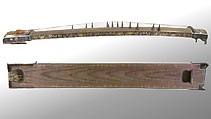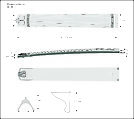Koto (箏)
Not on view
Koto music was introduced into Japan during the Nara period (710-84). It developed in the court and gradually entered the home as a sign of good breeding for daughters of the rising commercial class as well as those of the nobility. Nylon stringing and plastic bridges and plectrums are now replacing the traditional materials, silk for strings, ivory for its movable bridges (ji) and plectrums (tsume). Paulonia remains the wood used for the body of the zither.
Due to rights restrictions, this image cannot be enlarged, viewed at full screen, or downloaded.
This artwork is meant to be viewed from right to left. Scroll left to view more.


.jpg)
.jpg)
.jpg)


